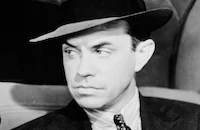Super-Sleuth

Brief Synopsis
Cast & Crew
Ben Stoloff
Jack Oakie
Ann Sothern
Eduardo Ciannelli
Alan Bruce
Edgar Kennedy
Film Details
Technical Specs

Synopsis
When popular, egotistical movie detective Willard "Bill" Martin states publicly that he could do a better job of solving murder cases than the Los Angeles police force, he aggravates not only the police, but Mary Strand, the head of his studio's publicity department, as well. Bill's screen "super sleuth" persona suddenly takes on reality when he receives a death threat from the "Poison Pen," an at-large celebrity killer who wants to murder Bill in retaliation for his last bad movie. After being shot at through the window of a Hollywood nightclub, a cocky, determined Bill goes with Mary, who secretly loves the dumb star, to see amateur criminologist and house-of-horrors owner Professor Herman, not realizing that Herman is, in fact, the Poison Pen. The next day, Herman shows up at Bill's movie shoot and, during a chase scene, accidentally kills Bill's co-star, Ralph Waring. Because Waring had fought earlier with his stand-in, Larry Frank, Larry is arrested for the crime. Convinced of Larry's innocence, Bill continues his confused efforts to find the Poison Pen, while Herman continues his poorly aimed murder attempts on Bill. Finally, Mary, to protect Bill from himself, tricks him into getting arrested and jailed. Bill "outsmarts" her, however, by calling Herman to bail him out. When Mary deduces that Herman is the Poison Pen, she and Warts, Bill's servant, notify the police and rush to Herman's "Crime Doesn't Pay" horror gallery, where, aided by Herman's clumsiness, they rescue Bill and catch the Poison Pen.

Director
Ben Stoloff
Cast

Jack Oakie

Ann Sothern

Eduardo Ciannelli
Alan Bruce

Edgar Kennedy

Joan Woodbury

Bradley Page

Paul Guilfoyle

Willie Best
William Corson
Alec Craig

Richard Lane
Paul Hurst
George Rosener
Fred Kelsey
Robert E. O'connor
Philip Morris
Dick Rush
Crew
Joseph Anthony
Joseph H. August
Samuel J. Briskin
William Hamilton
Al Herman
Kenny Holmes
Ernest Pagano
Van Nest Polglase
Gertrude Purcell
Harry Segall
Edward Small
Edward Small
Edward Stevenson
Vernon L. Walker
Earl A. Wolcott

Film Details
Technical Specs

Articles
Super Sleuth
By Frank Miller

Super Sleuth
Quotes
Trivia
Notes
Although the onscreen credits state that the screenplay was "from the play by Harry Segall," other contemporary sources indicate that Segall's story was a screen original. Motion Picture Herald's "In the Cutting Room" lists Frank M. Thomas in the cast, but his participation in the final film has not been confirmed.














